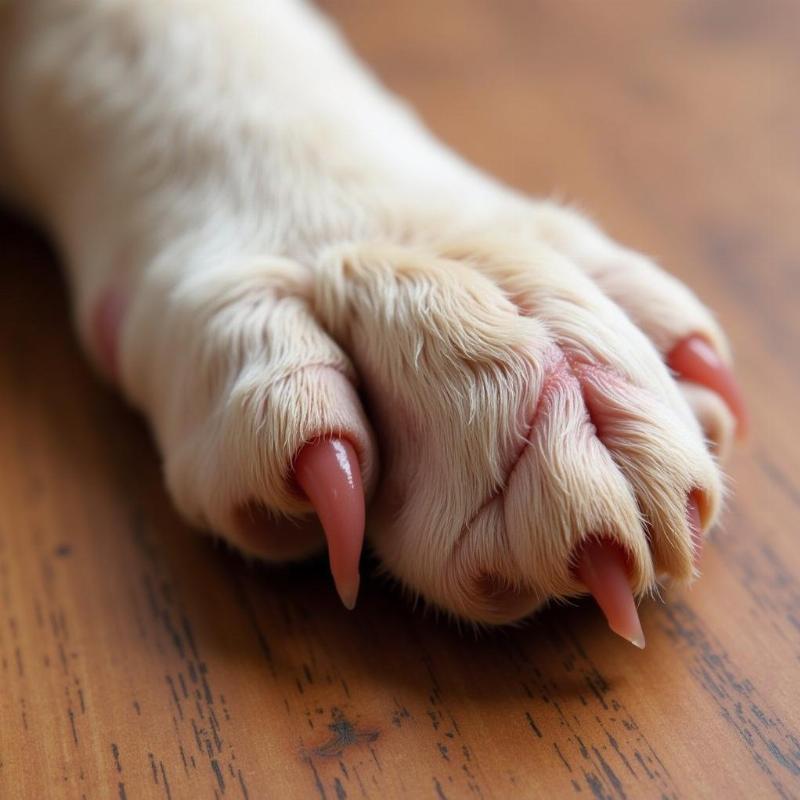If you’ve noticed your dog’s nails peeling, it’s natural to be concerned. Peeling nails can be a sign of several underlying issues, ranging from minor annoyances to more serious health problems. Understanding the potential causes can help you determine the best course of action to keep your canine companion healthy and comfortable. This article will explore the common reasons why your dog’s nails might be peeling, what you can do about it, and when it’s time to seek professional veterinary care in the US.
Common Causes of Peeling Dog Nails
Several factors can contribute to nail peeling in dogs. These range from environmental factors to underlying health conditions. Let’s delve into some of the most common culprits:
- Trauma: Just like human nails, dog nails can be damaged by physical trauma. This can include getting caught on something, being stepped on, or excessively long nails hitting hard surfaces during walks. This type of damage can lead to splitting, cracking, and peeling.
- Infection: Bacterial or fungal infections can weaken the nail and cause it to peel or become brittle. These infections can be painful and require veterinary treatment.
- Nutritional Deficiencies: A balanced diet is crucial for healthy nail growth. If your dog’s diet lacks essential vitamins and minerals, it can manifest in brittle and peeling nails.
- Allergies: Environmental or food allergies can sometimes cause inflammation in the paws, leading to secondary nail problems like peeling.
- Underlying Medical Conditions: Certain medical conditions like hypothyroidism or autoimmune disorders can affect nail health, making them more prone to peeling.
 Dog Nail Peeling Due to Trauma
Dog Nail Peeling Due to Trauma
What Can I Do About My Dog’s Peeling Nails?
Addressing peeling nails depends on the underlying cause. Here are some steps you can take:
- Trim Your Dog’s Nails Regularly: Keeping your dog’s nails trimmed to an appropriate length can prevent them from catching on objects and reduce the risk of trauma.
- Provide a Balanced Diet: Ensure your dog is eating a high-quality, complete and balanced diet recommended by the Association of American Feed Control Officials (AAFCO). Consult your veterinarian about adding supplements if necessary.
- Protect Paws From Harsh Environments: During hot weather, avoid walking your dog on scorching pavements which can burn and damage their paws and nails. In winter, consider using paw balm to protect against ice and snow.
- Address Allergies: If you suspect allergies, consult your vet. They can perform tests to identify allergens and recommend appropriate treatment, which may include medication, dietary changes, or environmental modifications.
When to See a Vet
While some cases of nail peeling can be managed at home, others require veterinary intervention. Contact your veterinarian if you notice:
- Signs of infection: Redness, swelling, pus, or a foul odor around the nail.
- Severe pain or lameness: Your dog is clearly uncomfortable or avoids putting weight on the affected paw.
- Excessive bleeding: If the nail is bleeding profusely.
- The nail is completely detached: This can be a sign of a serious injury or infection.
- Chronic peeling: If the peeling persists despite home care.
Preventing Dog Nail Peeling
Proactive measures can help prevent nail peeling in the first place. Here’s what you can do:
- Regular Nail Checks: Make it a habit to inspect your dog’s nails regularly for any signs of damage or abnormalities.
- Maintain a Healthy Lifestyle: Regular exercise, a balanced diet, and proper grooming contribute to overall health, including healthy nails.
- Consult with a Groomer: A professional groomer can help maintain your dog’s nails and identify potential issues early on.
Conclusion
Peeling dog nails can be a sign of various issues, from minor injuries to more serious underlying health problems. By understanding the potential causes and taking appropriate preventive measures, you can keep your dog’s nails healthy and strong. If you’re concerned about your dog’s nail peeling, don’t hesitate to consult your veterinarian for professional advice and treatment.
FAQ
- Can I use human nail clippers on my dog? No, human nail clippers are not designed for dog nails and can cause splitting or cracking. Use clippers specifically designed for dogs.
- How often should I trim my dog’s nails? The frequency depends on your dog’s breed and activity level. Generally, trimming every 2-4 weeks is recommended.
- What should I feed my dog for healthy nails? A balanced diet formulated for dogs, following AAFCO guidelines, is essential. Look for foods rich in biotin, omega-3 fatty acids, and other essential nutrients.
- Is nail peeling always a sign of a serious problem? Not always. Sometimes it can be caused by simple trauma. However, persistent peeling should be checked by a vet.
- Can allergies cause nail peeling in dogs? Yes, allergies can cause inflammation and secondary nail problems like peeling.
- How can I protect my dog’s paws in winter? Use paw balm or booties to protect against ice, snow, and de-icing chemicals.
- What should I do if my dog’s nail is bleeding? Apply pressure with a clean cloth and contact your veterinarian if the bleeding doesn’t stop.
Beautdogs.us is your premier online resource for comprehensive dog care information, breed-specific advice, and access to the best products for your canine companion. Whether you’re a new dog owner or a seasoned expert, Beautdogs.us provides authoritative, engaging, and accessible content to help you navigate the joys and challenges of dog ownership. We are dedicated to helping you build a strong bond with your furry friend through expert advice and tailored solutions. Contact us today to learn more! Email: [email protected], Phone: +1 501-555-7529. Visit Beautdogs.us for all your dog care needs!